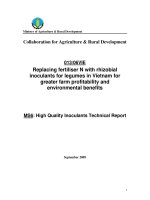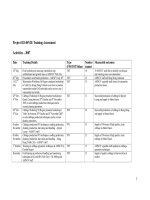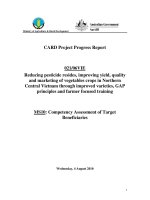Báo cáo khoa học nông nghiệp " COLLABORATIVE NATURAL RESOURCES MANAGEMENT " pptx
Bạn đang xem bản rút gọn của tài liệu. Xem và tải ngay bản đầy đủ của tài liệu tại đây (699.11 KB, 30 trang )
®
PRESENTATION IN
COMMUNITY FORESTRY MANAGEMENT WORKSHOP
BACKAN, 20-21 APRIL 2010
COLLABORATIVE
NATURAL RESOURCES MANAGEMENT
CARE’S EXPERIENCES AND LESSON LEARNT
®
Introduction
z Since 1989 CARE INTERNATIONAL (CARE
in Vietnam) has worked with Vietnamese
partners throughout the country to implement
over 160 different projects in 25 provinces
in three programming areas:
|Health/ HIV/AIDs/ AI & Social program
|Rural Development & Natural Resource
Management program and
|Emergency & CBDRM program
®
Community Empowerment for
Forest Management
(Danida)
Bac Kan
(2006-2009)
Agriculture Gifts
(CARE Aus)
Hoa Binh
(2009)
Social Inclusion in Economic
Enterprise Development-
SIEED, Dien Bien
(2008-2012)
Community based Mangrove
Reforestation
in Thanh Hoa
(Precision Foundation)
(2006-2009)
Joint Advocacy Network Initiative
(DIPECHO)
HaNoi
(2008-2009)
Avian Influenza
(AusAID, CDC, ABBOTT)
Bac Ninh, Thanh Hoa,
Dong Thap, An Giang,
Tien Giang, Can Tho,
Hai Phong
(2006-2009)
Participatory Community
Development (PACODE)
(Danida)
An Giang & Soc Trang
(2004-2009)
Options and Ownership:
WatSan for Rural Poor in the
Mekong Delta
(AusAID)
Ca Mau, Soc Trang
(2005-2010)
Supporting the Law by Understanding HIV and
Training in the Practice of Human Rights
Advocacy for PLHIV
(EC)
Hanoi, HCMC
(2009-2010)
Community Resilience
to Natural Disasters
in the Mekong Delta (CRND)
(AusAID)
An Giang, Dong Thap,
Long An
(2005-2009)
Striving for Transformation for
Empowered People (STEP)
(AusAID)
Can Tho, An Giang
(2008-2009)
Using Participatory Learning and Action
Methodologies to Address ASRH Issues
among Youth Ethnic Groups
in Yen Bai province
(Ford Foundation)
(2009-2010)
Water and Sanitation Education and
hygiene Promotion for Schools
(The Harold Simmons Foundation)
Thanh Hoa
(2007-2010)
Women’s Livelihood
and
Rights Clubs – phase
II
(Danida)
Hoa Binh and Bac Kan
(2007-2009)
Participatory Watershed
Management
(Danida), Thanh Hoa
(2007-2009)
Effective Networking
for a Better Learning
Environment (ENABLE)
(Danida))
Hanoi, Hoa Binh, Thai Nguyen,
Bac Kan, Thanh Hoa
(2007-2009)
BẮC NINH
ĐàNẵng
LONG AN
HÒA BINH
THANH HÓA
ĐỒNG THÁP
CẦN THƠ
CÀ MAU
SÓC TRĂNG
BẮC KẠN
THÁI NGUYÊN
HẢI PHÒNG
TiềnGiang
BếnTre
Lai Châu
Lào Cai
Hà Giang
Cao Bằng
Tuyên
Quang
Lạng sơn
Bắc Giang
Phú
Thọ
Vĩnh Phúc
HÀ NỘI
Nam Định
Ninh Bình
NGHỆ AN
Hà Tĩnh
Quảng Bình
Quảng Trị
Thừa Thiên Huế
Kon Tum
Quảng Ngãi
Gia Lai
Phú Yên
Dak Lak
Khánh Hoà
Dak Nong
Lâm Đồng
Ninh Thuận
Bình Phước
Tây Ninh
Bình
Dương
Đồng Nai
Bình Thuận
Bà Rịa
Vũng Tàu
Vĩnh Long
Trà Vinh
BạcLiêu
Kiên Giang
Thanh Hoa Disaster Preparedness
(DIPECHO)
Thanh Hoa
(2008-2009)
Local Partnership Initiative-
HIV/AIDS care and support-
Community Contributions
to the CARE Continuum
(PACT)
Quang Ninh
(2008-2009)
Stronger Organization, Networks, GIPA for an
Empowered Response to HIV/AIDS
(USAID)
Hanoi, HCMC, Quang Ninh, Can Tho, An Giang &
Nghe An
(2009-2010)
AN GIANG
HCMC
SơnLa
Bình
Định
THANH HÓA
ĐỒNG THÁP
CÀ MAU
SÓC TRĂNG
YÊN BÁI
BẮC KẠN
THÁI NGUYÊN
Hưng Yên
Đ
I
Ệ
N
B
I
Ê
N
Lai Châu
Lào Cai
Hà Giang
Cao Bằng
Tuyên
Quang
Lạng sơn
Bắc Giang
Phú
Thọ
HÀ NỘI
THÁI BÌNH
Hà Tĩnh
Quảng Bình
Quảng Trị
Thừa Thiên Huế
QUẢNG NAM
Kon Tum
Quảng Ngãi
Gia Lai
Phú Yên
Dak Lak
Khánh Hoà
Dak Nong
Lâm Đồng
Ninh Thuận
Bình Phước
Tây Ninh
Bình
Dương
Đồng Nai
Bình Thuận
Bà Rịa
Vũng Tàu
Vĩnh Long
Trà Vinh
BạcLiêu
Kiên Giang
AN GIANG
QUẢNG NINH
Financial Security for Young People in Vietnam
Long An
(2009-2012)
Emergency Response to
Typhoon Ketsana in
Quang Nam
(2009-2010)
Where CARE in Vietnam working
Thai Nguyen Women’s
economic Collaboration for
Development
(EU-CARE Danmark)
Thai Nguyen
(2008-2012)
®
z CARE in Vietnam has been implementing three
forestry-based rural development projects in
northern Vietnam since 2006 within framework
of Rural Development and Natural Resource
Management Program.
z Target group: Rural poor, women, ethnic minority
and other vulnerable groups
Rural Development and Natural Resource
Management Program
®
Program Objectives (1)
z Promoting sustainable natural resource
management (NRM)
- Establishing community based management systems and
structures for forests, land and watersheds, SALT, PES
- Support to disaster risk reduction and adapting to climate
change
z Increasing poor peoples participation in decision
making
- Raising awareness on laws and rights, participatory planning
processes, capacity building of community or women’s groups
to speak out in decision making fora
- Promoting development of civil society from grass-root level
to national levels (Community NRM Boards, collaboration
groups, other forms of community based organizations, mass
organizations, VNGOs)
®
Program Objectives (2)
z Building capacity and accountability of local
service providers
- Participatory approaches to respond to needs (e.g
farmer field schools)
- Linking community groups and service providers
(e.g. savings and credit schemes)
- Small-scale enterprise development, business
p
lanning, access to markets using a value chain
approach
®
1.Participatory Watershed Management (PWM)
Project in Ba Thuoc Dist, Thanh Hoa province
2.Community-based Mangrove Reforestation
and Management (CBMRM) Project in Hau
Loc Dist, Thanh Hoa province
3.Community Empowerment for Forest
Management (CEFM) Project in Cho Don
Dist, Bac Kan province
Collaborative NR Management within CARE
®
PWM in Ba Thuoc
CEFM in Cho Don
CBMRM in Hau Loc
®
Community Based Watershed Management
• Participatory Watershed Management
- Community based future landscape
planning
- Natural resource benefit sharing
• Sloping land techniques (SALT)
- Afforestation
- Diversification
®
Mangroves project Hau Loc Dist:
| Storm protection
| Sustainable livelihoods for poor and
landless people
| High Carbon storage and other
environmental benefits
| Community confidence and
management
- Environmental and CC
awareness raising and
education
Community Based Mangrove Management
®
Community Empowerment Forest Management
CEFM project in Cho Don Dist:
| Household Sustainable forest
management
| Sustainable livelihoods for poor
and landless people
| Forest management awareness
®
Conceptual framework for
collaborative NR management and governance
Limited
contribution from
government
Limited
contribution from
other stakeholders
Transferring
authority
Pluralistic
institutions and
processes guiding
decision making
Negotiating
specific
agreements
Actively
consultation other
stakeholders
Transferal of
responsibilities
/benefit to other
stakeholders
Sharing power
between
government and
other stakeholders
Sharing
responsibilities/be
nefits between
government
No sharing of
responsibilities/be
nefits between
government and
other stakeholders
Community based
NR managementShared governanceCo-management
State management
outreach
Collaborative natural resource management and governance
®
z Collaborative NR management and governance:
All key stakeholders discuss objectives and accept roles,
rights and responsibilities to change levels of participation
z State management outreach: No sharing
responsibilities/benefits from NR between Government and
other stakeholders
z Co-management: Fair sharing of management functions,
benefits and responsibilities and decisions made by more
than 1 stakeholders
z Share governance: Sharing powers, responsibilities and
accountability for NR management
z Community based natural resources
management:
NR managed by communities who have
legal rights, transferred from the Government.
Conceptual framework in specific
®
Implementation Strategies and Approaches
z The visioning approach was applied in the
establishment of participatory watershed
management system in PWM and
community based mangrove management
system in CBMRM project
z The sustainable forest management strategy
was adopted in the establishment of
Sustainable Household Forest Management
(SHFM) and Forest Protection and
Development (FPDG) groups
®
Collective experiences
| Process (engagement of multiple stakeholders, empower
local communities to influence local government in planning
and decision making process)
| Social equity and Livelihood security (equitable
participation/access to NR/ gender division labor; awareness
raising; empowered voice; community cohesion; greater
ownership; sustainable livelihoods; improved risk
management; capacity and confident development)
| Improved governance (strengthened dialogue;
collaborative NRMG; capacity building for CSO; and more
equitable legal frameworks)
| Natural environment (considered ecological factors and
climate change impacts in NR management; promoted
natural resource based ecosystem services)
®
Process (1)
How to facilitate meaningful multiple stakeholders
engagement in NR management?
z
A
pplication of international best practices
within Vietnamese context
z Intervention logic based on economic theory
for collaborative NR management
z Focus on process as opposed to prescribed
activities and outputs
z Institutionally partnering and maintaining
dialogue with local government agencies
®
z Dedicating adequate timeframe to collaborative
NR management process
z Participatory community development training
essential to self-learning
z Organizing committee into new CBOs that fit in
to current system
z Participatory data collection, review, visioning
and strategizing/planning
Process (2)
®
Social equity and livelihoods (1)
How to equitably realize the livelihood potential
of community-based NR management?
z Collaborative NR management can yield
significant positive and multiple benefit
outcomes
z Immediate focus on securing resource access
and sustainable use rights
z Short and long-term incentive couplings
®
z Empowerment and capacity building through
collaborative NR management institutions
z Selective targeting of relatively better-off
households
z Market viability and potential of commercial
livelihood models
Social equity and livelihoods(2)
®
Improved governance (1)
How to contribute to the formulation of policy,
institutions and processes and internalize decision-
making?
z Creating incentives for mainstreaming collaborative
management
z Responding to existing policy and legislative
framework opportunities
z Educating communities on national legislative and
regulatory frameworks
®
z Building on existing local practices of NR
management
z Disseminating lessons learnt to contribute to
the decision making process
Improved governance (2)
®
z Consideration of spatial and temporal contexts of
wider landscapes
z Projected trends in environmental dynamics
z Consideration of ecological factors presenting risks
and opportunities
z Demonstrating innovative models of Natural
resources governance
Natural environment
®
Guidance to practioners (1)
z Phase 1 : Preparation
- Mapping the project area for natural resources
development and livelihoods potentials
- Project development and approval with
government
- Establishing a Project Management Board
®
Guidance to practioners (2)
z Phase 2: Organisation
- Participatory Rural Appraisal (PRA)/ Analysis -
gathering information
- Develop community-Based Management Board –
new institution
- Develop technical groups (nursery, planting,
protection & livelihood)
- Organize study tour/field visit and technical
training (nursery, planting & protection skills)
®
Guidance to practioners (3)
z Phase 3: Negotiation
- Review existing management system
- Vision-setting – common vision
- Strategising – identifying problems and solutions
- Negotiating - specific agreements & actions –
village regulations, district decisions









